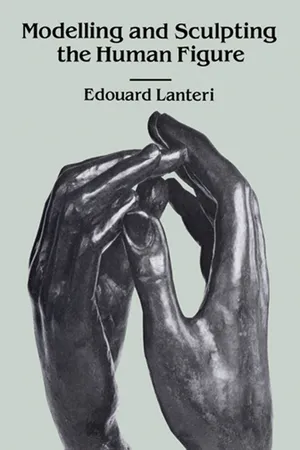
- 480 pages
- English
- ePUB (mobile friendly)
- Available on iOS & Android
Modelling and Sculpting the Human Figure
About this book
Is there art after modernism? Many of today's art students and professionals are finding the answer — "yes" — lies in the long-neglected field of figurative sculpture, a demanding form of expression that requires extremely rigorous technical training. Most modern schools, however, are simply not equipped to provide the necessary technical background. The republication of this highly valuable text by Edouard Lanteri, renowned teacher, sculptor, and intimate friend of Rodin (Rodin called him "my dear master, my dear friend"), makes it possible for serious students to gain the requisite skills and bridge the gap between artistic concept and figurative realization. Representing at least three thousand years of studio lore, this readily understandable, authoritative guide is a goldmine of technical information, easily comprising a four-year sculpture curriculum unavailable elsewhere.
Beginning with a detailed study of modelling a head from a cast model, Lanteri gives meticulous descriptions of the anatomical features that comprise the head. Next, there are instructions for sculpting a bust from a live model: how to place the model, use the clay, take measurements, set up the all-important framework, put on hair, etc. The author also covers modelling the figure from nature, including such factors as the scale of proportions, posing the model, the chief line, contrasts of line, building up the figure, and more.
Part III covers sculpting in relief (poses, fixing the background, tools, superposition of planes, color, change of light, etc.); drapery (arrangement of folds, principles of radiation, flying drapery, etc.); and medals (proportion, working the mold, inscriptions, etc.). Also discussed are principles of composition, both in relief and in the round. Profusely illustrated with hundreds of photographs, drawings, and diagrams, this work is the kind of comprehensive resource that should be a lifelong studio companion to the figure sculptor. 107 full-page photographic plates, 27 other photographs, 175 drawings and diagrams.
Frequently asked questions
- Essential is ideal for learners and professionals who enjoy exploring a wide range of subjects. Access the Essential Library with 800,000+ trusted titles and best-sellers across business, personal growth, and the humanities. Includes unlimited reading time and Standard Read Aloud voice.
- Complete: Perfect for advanced learners and researchers needing full, unrestricted access. Unlock 1.4M+ books across hundreds of subjects, including academic and specialized titles. The Complete Plan also includes advanced features like Premium Read Aloud and Research Assistant.
Please note we cannot support devices running on iOS 13 and Android 7 or earlier. Learn more about using the app.
Information
MODELLING AND SCULPTING THE HUMAN FIGURE
Section Two
CONTENTS
No absolute laws for relief
Poses suitable for relief
Method of fixing the background
Background fixed vertically
Consequence of not fixing the background vertically
Method of starting a relief
Illustrations showing this method
Suitable modelling tool for relief
Another method of starting the relief
Illustration of this method
The substance of the figure is essential in relief
Superposition of planes necessary to give substance
Character of form in the shoulder given by superposition of planes
Character of form in the shoulder given by neglect of superposi-
tion of planes
Superposition of planes in the leg
Superposition of planes in the foot
Superposition of planes in the arm
Superposition of planes in the torso (three-quarter view)
Continuation of the relief
Doll-like effect given by neglect of superposition
Insipid appearance given by neglect of superposition
Colour in relief
Smaller planes placed on the large surfaces
Palette of the modeller in relief; comparative tone-value in
the model and in relief
Relief from Nature
Change of light in working relief
The fold studied
The eye of the fold showing the starting-point of the planes
Stick of clay pressed showing the projection above the eye
Projection of the eye of the fold
Rapid movement of planes round the eye of the fold
Silk: showing the angular character of the eye
Velvet: showing the rounded character of the eye
Muslin: showing the soft character of the folds
Greek use of muslin for drapery
Exaggeration of the principle in oil-cloth
Group of folds suitable for copying.
Method of starting the copy
Second stage of the copy
Interior part to finished first
Gothic drapery: section of the folds
Third stage of the copy
Copy in clay of Fig
Tools ...
Table of contents
- Dover Books on Art Instruction and Anatomy
- Title Page
- Copyright Page
- Table of Contents
- Introduction To Dover Edition
- Publisher’s Note
- Section One
- MODELLING AND SCULPTING THE HUMAN FIGURE - Section Two